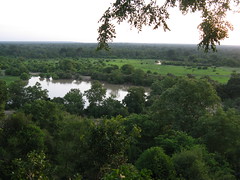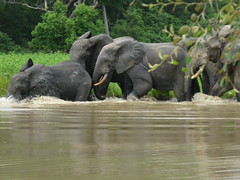
The View I spent so much Time Looking at While at Mole National Park, Ghana
Originally uploaded by Daniel Kerkhoff
This is the view from the observation deck at Mole Motel in Mole National Park.
According to my Bradt Guide, Mole National Park is Ghana's largest wildlife sanctuary, about 4,480 square kilometres. It has more than 90 mammal species and 344 bird species. There are about 800 elephant, 1,100 buffalo, hippos, warhogs, and antelope species such as kob, Defassa waterbuck, bushbuck, and roan.
At 6:30 am on Monday, July 13, I started walking from the village of Larabanga to the Mole Motel, about 5km on a gravel road. Along the way, I saw Pata Monkeys and Kob Antelope. The guinea fowl crossed in front of me, and a warthog and I passed each other on the road, both of us keeping our eyes on the other. When I got to the Mole Motel, warthogs were on the front lawn eating grass. One stared me down and snorted at me. I already felt like I had my fill, and it was only 8 am.
At the motel restaurant, right in front of the swimming pool, I ate a tasty breakfast --an onion and mushroom omelet and coffee. Then, I proceeded to the observation deck where I stayed for the rest of the day until 7pm; that is, when I wasn't going back for another refreshment.
Just all the green alone could have kept me fixated at that observation deck, but there were also various antelope down there grazing, chasing each other, trevassing and lounging. At around 10 am, I saw big trees moving, and then some grey, and then out came the large pachyderms. Five elephants slowly made their way to the watering hole and started swimming. They submerged themselves turning from light, dusty grey to almost black. Their trunks would rest on each other's backs and intertwine as they waded around for a couple hours. These were all males. The females were with their young in the bush. I also saw a couple crocodiles floating like logs not too far away from the elephants.
People come and go, various volunteers from Europe or the States, and we have little chats while were looking out over the expanse. I talked with David, a Ghanaian studying biology at Novrongo. He said he was doing some research at the park for three weeks. He told me that there were about 100 lions in the park but they are being reduced. They believe it is due to inbreeding. He was researching creating migration corridors between Mole NP and another park in Burkina Faso. The corridors would be about 200 km wide and would alleviate the inbreeding problem. He also said there were hyenas around, but they were very endangered. Park rangers go through the park and search for poachers.
At around 2 pm, three elephants are back in the water playing and swimming. Six elephants all together are near the watering hole. Baboon monkeys occasionally pass behind me looking for some grub in the trash cans or on some unsuspecting tourists table. One surprises me by knocking over the trash can about 10 feet away. I don't have anywhere else to go. Luckily, I don't have a sandwich in my hand. He moves on to the swimming pool, and I hear some women scream. Later, I talk to a European guy who says the baboon jumped on his table and grabbed his sandwich.
I eat guinea fowl for dinner and am back at the observation deck to watch the sunset. Just when it's getting too dark below to notice much, I spot some very dark shapes moving across the slightly lighter grasses. Judging by their size, I reckon they are African Buffalo, about 50 of them walking slowly. Thus ended my day at the deck before I retire for another refreshment. The whole day seemed surreal, like I was some hawk watching a hyper-real, HD, computer generated, digital paradise.
The next day, I woke up at 5:30 am and was back at the observation deck. I'm all alone, misty layers upon layers of light and dark green canopies of trees for miles and miles. Below on the grass, the brown kob and bushbuck antelope go out into the green fields to do some grazing. Hugh Masekela's "Grazing in the Grass".
At 7am, I head over to the visitor's center to go on a two hour walking safari, only six cedis (about $4.00) for a 2 hour plus safari. Along the way, I encounter about 30 baboons walking towards me. I step to the side and hope they just pass me by. At the visitor's center, I put on my Wallenting boots, tall rubber boots, for the walk and wait around with some Europeans. A big group of South Korean students arrive. Then, out of the bush comes an elephant with big tusks. Everybody starts taking pictures and are excited. The Koreans get too close and the guides warn them to stay back. You're supposed to stay 50 meters, but we all get too close because a couple more elephants come and mosey by us to eat some of the nice shrubs and grasses.
I get with a group of 10 people and our guide starts walking us out towards the bush. We see green monkeys and many many kob antelope watching us, then prancing away. We see bushbuck which have incredible white lined markings like tattoos. We also see Defassa waterbuck. Our guide shows us a natural salt-lick. It's smooth, light gray rocks are visited by the antelope and the elephants for a little treat and necessary nourishment. We walk all around the areas I had seen from the observation deck. When we get to the watering hole, there are a couple elephants bathing. Then, some more come into the water and they all swim and play and we watch and take photos. On our way back to the hotel, we come upon a elephant in the bush, only 10 meters from us. Our guide quickly takes his rifle from his shoulder and tells us to back off and go around. As I'm moving away, I snap a photo.

Elephants Going in for a Swim, Mole National Park, Northern Ghana
Originally uploaded by Daniel Kerkhoff
Watching these elephants go for a swim while we were on safari was pretty cool.
This green monkey and her baby passed me while I was eating breakfast. Many baboons were around and would get close. The waitress gave me a big silver platter to use to scare them away. I would stand up occasionally and wave my platter and then go back to my coffee and omelette. On my last morning in the park, I sat at the observation deck and about a dozen green monkeys were eating leaves off the trees around me. The way they ate, those leaves must have been tasty.
West Africa isn't really known for its wildlife and safaris. Most people go to east Africa and southern Africa for that and I've seen some amazing photos from there showing what most people associate with Africa. But Mole NP was a wonderful place, not very crowded or on the beaten path. The motel had its comforts and the rainforest and animal and bird life were mesmerizing.

Thanks Daniel for sharing that amazing experience.
ReplyDelete